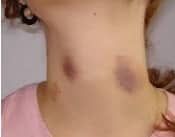In order to know the meaning of the term ecchymosis, it is necessary, first of all, to discover its etymological origin. In this case, we can determine that it is a word that derives from Greek, specifically from "ekkhymosis." This can be defined as a "stain on the skin generated by a collection of blood in the subcutaneous area" and is the result of the sum of the following lexical components:
-The prefix «ek-«, which means «outwards».
-The noun "khymos", which can be translated as "flow."
-The suffix «-osis», which is used to indicate a pathological process.
Used in the field of medicine, the term ecchymosis refers to a stain that appears on an internal organ or on the skin as a result of imbibition of blood due to a blow or other reason.
Synonyms of ecchymosis are also bruise and bruise.
 Ecchymosis, therefore, is an injury that constitutes a clinical sign. The extravasated blood infiltrates the subcutaneous tissue, generating a spot of variable size depending on the type of contusion.
Ecchymosis, therefore, is an injury that constitutes a clinical sign. The extravasated blood infiltrates the subcutaneous tissue, generating a spot of variable size depending on the type of contusion.
What ecchymosis reveals, in short, is the rupture of a blood vessel . This situation causes internal bleeding to occur and the blood to soak into the tissue, becoming visible on the skin by the appearance of a stain. The action of various cells and enzymes causes the stain to change color, ranging between reddish-blue, greenish and brown.
In addition to all the above, we cannot ignore that an ecchymosis is considered a first degree contusion. This is more serious than the so-called simple contusion, which can cause simple redness of the skin, and is milder than others. Specifically, it is milder than second-degree contusions or hematomas and third-degree contusions, which involve the death of the deeper tissues of the skin.
Typically, an ecchymosis is between one and two centimeters long. When the size is smaller, the lesion is usually called petechia . On the other hand, if the subcutaneous blood accumulation generates a rise in the skin , it is called hematoma .
Ecchymoses cause pain as the nerves in the area of the bruise are affected by the blow. In any case, no action is usually required as treatment since the discomfort naturally ceases over time.
In the same way, we cannot ignore the existence of what is known as a Hennequin hematoma, which is an ecchymosis on the inside of the arm as well as in the chest area that occurs at 48 hours after the cause that generated it occurred. Furthermore, it will be associated with pain and even deformity.
